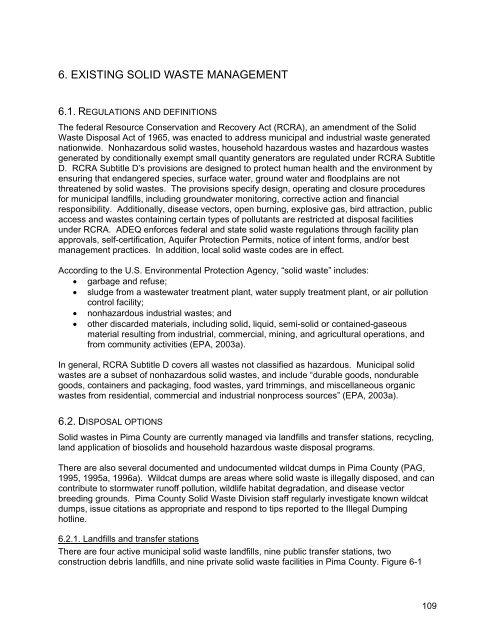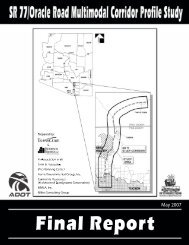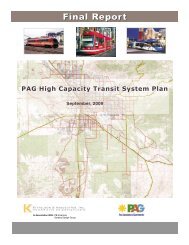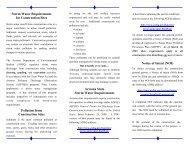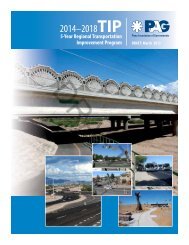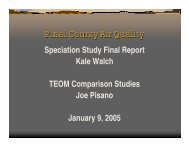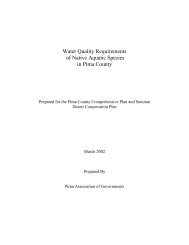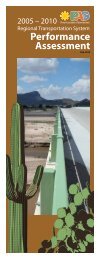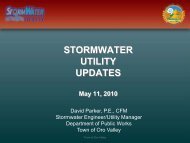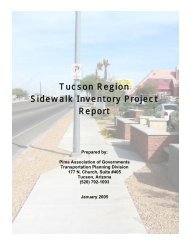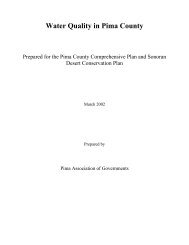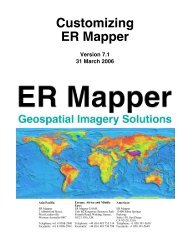6. EXISTING SOLID WASTE MANAGEMENT
6. EXISTING SOLID WASTE MANAGEMENT
6. EXISTING SOLID WASTE MANAGEMENT
Create successful ePaper yourself
Turn your PDF publications into a flip-book with our unique Google optimized e-Paper software.
<strong>6.</strong> <strong>EXISTING</strong> <strong>SOLID</strong> <strong>WASTE</strong> <strong>MANAGEMENT</strong><br />
<strong>6.</strong>1. REGULATIONS AND DEFINITIONS<br />
The federal Resource Conservation and Recovery Act (RCRA), an amendment of the Solid<br />
Waste Disposal Act of 1965, was enacted to address municipal and industrial waste generated<br />
nationwide. Nonhazardous solid wastes, household hazardous wastes and hazardous wastes<br />
generated by conditionally exempt small quantity generators are regulated under RCRA Subtitle<br />
D. RCRA Subtitle D’s provisions are designed to protect human health and the environment by<br />
ensuring that endangered species, surface water, ground water and floodplains are not<br />
threatened by solid wastes. The provisions specify design, operating and closure procedures<br />
for municipal landfills, including groundwater monitoring, corrective action and financial<br />
responsibility. Additionally, disease vectors, open burning, explosive gas, bird attraction, public<br />
access and wastes containing certain types of pollutants are restricted at disposal facilities<br />
under RCRA. ADEQ enforces federal and state solid waste regulations through facility plan<br />
approvals, self-certification, Aquifer Protection Permits, notice of intent forms, and/or best<br />
management practices. In addition, local solid waste codes are in effect.<br />
According to the U.S. Environmental Protection Agency, “solid waste” includes:<br />
• garbage and refuse;<br />
• sludge from a wastewater treatment plant, water supply treatment plant, or air pollution<br />
control facility;<br />
• nonhazardous industrial wastes; and<br />
• other discarded materials, including solid, liquid, semi-solid or contained-gaseous<br />
material resulting from industrial, commercial, mining, and agricultural operations, and<br />
from community activities (EPA, 2003a).<br />
In general, RCRA Subtitle D covers all wastes not classified as hazardous. Municipal solid<br />
wastes are a subset of nonhazardous solid wastes, and include “durable goods, nondurable<br />
goods, containers and packaging, food wastes, yard trimmings, and miscellaneous organic<br />
wastes from residential, commercial and industrial nonprocess sources” (EPA, 2003a).<br />
<strong>6.</strong>2. DISPOSAL OPTIONS<br />
Solid wastes in Pima County are currently managed via landfills and transfer stations, recycling,<br />
land application of biosolids and household hazardous waste disposal programs.<br />
There are also several documented and undocumented wildcat dumps in Pima County (PAG,<br />
1995, 1995a, 1996a). Wildcat dumps are areas where solid waste is illegally disposed, and can<br />
contribute to stormwater runoff pollution, wildlife habitat degradation, and disease vector<br />
breeding grounds. Pima County Solid Waste Division staff regularly investigate known wildcat<br />
dumps, issue citations as appropriate and respond to tips reported to the Illegal Dumping<br />
hotline.<br />
<strong>6.</strong>2.1. Landfills and transfer stations<br />
There are four active municipal solid waste landfills, nine public transfer stations, two<br />
construction debris landfills, and nine private solid waste facilities in Pima County. Figure 6-1<br />
109
shows the locations of the landfills and transfer stations, and Table 6-1 indicates the historical<br />
tonnage volumes disposed of at each landfill.<br />
Figure 6-1. Public Landfills and Transfer Stations in Pima County<br />
110
Table 6-1. Disposal Tonnage per Landfill, 1996 – 2002<br />
(ADEQ, 1997, 1998, 1999, 2000, 2001, 2002)<br />
Landfill Name 1996<br />
4/1997-<br />
3/1998<br />
4/1998-<br />
3/1999<br />
4/1999-<br />
3/2000<br />
4/2000-<br />
3/2001<br />
4/2001-<br />
3/2002<br />
Ajo Municipal 11,864 3,322 3,322 3,322 3,322 2,206<br />
Ina Road Municipal 3,687* 20,072 19,977 31,108 24,658 34,198<br />
Sahuarita Municipal 30,649 29,197 30,505 32,549 42,342 61,922<br />
Tangerine Municipal 171,005 87,216 70,004 78,482 101,736 117,888<br />
Resource Recovery<br />
Trust-Speedway<br />
Harrison Road<br />
Municipal<br />
46,160 41,354 51,737 54,821 38,345 24,345<br />
228,046 Closed<br />
Los Reales Municipal 315,918 466,706 427,338 509,990 529,463 515,321<br />
ASARCO Mission 427 854 425<br />
ASARCO Silver Bell 37 121 58<br />
Cyprus Sierrita 797 1,593 360<br />
*ADEQ indicates “inactive”<br />
Three of the four active municipal solid waste landfills (Ajo, Tangerine Road, Sahuarita) are<br />
owned and operated by Pima County (ADEQ, 2004d). A small landfill serving the Ajo area, the<br />
Ajo landfill is 17.6 acres. Pima County Solid Waste Division estimates it will reach its capacity in<br />
another two years, at which time a (most likely vertical) expansion will be needed. Located near<br />
Tangerine Road and I-10, the Tangerine Road Landfill also is nearing capacity. Pima County<br />
Solid Waste Management Division staff are in the process of vertically expanding the landfill to<br />
extend its operational life by one and a half years to mid 2007. It is currently 52 acres. The<br />
Sahuarita Landfill is located near Helmet Peak Road and La Canada on the west side of the<br />
Town of Sahuarita. An expansion permitting process is also in progress for that site. It is<br />
currently approximately 20 acres, and the expansion would add another 21 acres, 2.8 million<br />
cubic yards, and another 15 years to the site. Pima County municipal solid waste landfills<br />
accept wastes from private refuse hauling companies and residential self-haulers.<br />
The other municipal solid waste landfill in Pima County is owned and operated by the City of<br />
Tucson (ADEQ, 2004d). Operated by its Environmental Services Department, the Los Reales<br />
Landfill is the largest landfill in Pima County. It is currently 220 acres and 110 feet above grade<br />
in places, with a planned expansion to 430 acres. The proposed expansion should extend the<br />
capacity of the landfill 60 years (Mikolaitis, 2005) from its current fill date of 2016 (City of Tucson<br />
Environmental Services, 2002). Los Reales accepts waste from the City of Tucson residential<br />
and commercial refuse trucks, private refuse hauling companies and residential self-haulers.<br />
There are three private, industrial landfills in Pima County. Two are owned by ASARCO Inc.,<br />
and are located at the Mission Road and Silverbell mines. The other one is owned and<br />
111
operated by Cyprus-Sierrita Corp. for its mining operations. Both hold mining wastes and do not<br />
accept wastes from outside parties.<br />
Pima County’s Ina Road Landfill and the private Resource Recovery Trust-Speedway landfill in<br />
Tucson are construction debris landfills for commercial haulers only. A former municipal solid<br />
waste landfill, the Ina Road landfill is located near Ina Road and I-10. As a result of nearing<br />
capacity elevations, expansion plans will have to be drafted in the near future. It is currently 75<br />
acres.<br />
Both Pima County and the City of Tucson operate transfer stations. Pima County owns and<br />
operates eight transfer stations throughout the county, and the City of Tucson operates one.<br />
Refer to Figure 6-1 for locations. Roll-off bins are provided in Three Points, Why, Lukeville, Mt.<br />
Lemmon, Sasabe and Arivaca, and are periodically hauled to the county landfills. Permanent<br />
transfer station sites are in Catalina and Ryan Air Field. They accept bagged household trash,<br />
green waste, and wood from self-haulers and private trash companies. According to ADEQ<br />
records (ADEQ, 2005a) there are two private transfer stations in Pima County. Waste<br />
Management Inc. owns a transfer station on Ina Road, west of the I-10 interchange. Located<br />
southwest of the Tucson Airport, Pacific Waste Disposal Services also operates a private<br />
transfer station.<br />
<strong>6.</strong>2.2. Biosolids<br />
Biosolids are the solid components of treated raw sewage. Sewage from Pima County<br />
Wastewater customers in metropolitan Tucson and private septage haulers is treated for volatile<br />
solids and pathogens at the Ina Road Water Pollution Control Facility (WPCF) and the Roger<br />
Road Wastewater Treatment Plant. From there, biosolids are transported to the Regional<br />
Biosolids Management Facility (RBMF) located near the Ina Road WPCF. At the RBMF,<br />
biosolids are further thickened. They are then transported to area farms for land application.<br />
Table 6-2 indicates the biosolids volume applied to area farms over the last four years, and the<br />
number of participating farms. In 2004, all of the participating farms were located in the Marana<br />
area (Pima County WWM, 2005). Agricultural lands in the Marana area have been receiving<br />
biosolids since 1983 (McGinley, 2002).<br />
Table 6-2. Historical Volumes of Land Applied Biosolids<br />
(Pima County WWM, 2002a, 2003, 2004, 2005)<br />
Year Sites (number) Volume (dry tons)<br />
2001 27 8,721.80<br />
2002 38 8,188.78<br />
2003 36 7,567.4<br />
2004 24 8,455.65<br />
There are several state and federal regulations covering land application of biosolids to protect<br />
human health and the environment. Public access to fields where biosolids are applied is<br />
restricted. Lag times between application and harvest are called for, and biosolids must be<br />
prevented from entering waterways. Land-applied biosolids must meet vector attraction,<br />
pathogen, metals and nitrate standards. State rules (R18-9-1005) also limit cumulative pollutant<br />
loading rates for metals and the types of crops that can be harvested where biosolids are<br />
applied.<br />
Pima County is researching the feasibility of applying biosolids from the Green Valley<br />
Wastewater Treatment Plant to Asarco’s Mission Mine tailings as part of a revegetation effort<br />
112
(Pima County, 2004a). Developing a method to produce higher quality biosolids from lower<br />
quality biosolids and evaluating the potential health and environmental effects from revegetating<br />
mine tailings with biosolids constitute the core of the research.<br />
Small public and private wastewater treatment plants employ many biosolids disposal options.<br />
Transport to the regional Pima County wastewater treatment plants (Roger Road and Ina<br />
Road), land applied at the treatment facility, dried in drying beds or landfilled constitute the most<br />
common disposal options (Pima County WWM, 2003).<br />
<strong>6.</strong>2.2.1 Septage<br />
Pima County Ordinance 13.20.060 requires septage haulers to transfer all loads to the Roger<br />
Road Septage Receiving Facility at the Roger Road Wastewater Treatment Plant, acquire a<br />
discharge permit and pay a disposal fee. At the receiving facility, the septage is degritted and<br />
equalized and then introduced to the influent of the Roger Road WWTP. In 2001, nearly 2.7<br />
million gallons were transferred to the RBMP, and 1.6 million gallons were transferred in 2002<br />
(Pima County WWM, 2002a; Pima County WWM, 2003).<br />
<strong>6.</strong>2.3. Recycling<br />
Recycling solid wastes as an alternative to landfilling is encouraged in many communities.<br />
Pima County and the City of Tucson provide extensive recycling programs for common<br />
recyclable materials like aluminum cans, newspapers, plastics, glass, paper and cardboard.<br />
Services include weekly, curbside pick-ups of commingled, unsorted materials for residential<br />
and commercial customers. In addition, neighborhood recycling center drop-off bins are located<br />
throughout metropolitan Tucson. Approved recyclables also can be dropped off at Davis-<br />
Monthan Air Force Base, Los Reales Landfill, Catalina Transfer Station, Sahuarita Landfill and<br />
Tangerine Landfill. The neighborhood recycling centers and other sites recycle the same<br />
materials as the weekly pick-ups.<br />
In addition, metal appliances, scrap metal, passenger car and truck tires, and computers and<br />
peripherals can be dropped off at the Los Reales Landfill, Catalina Transfer Station, Sahuarita<br />
Landfill, and Tangerine Landfill for recycling. Both jurisdictions, through contracted<br />
intermediaries, sell the materials as raw materials to manufacturers making new products.<br />
Table 6-3 indicates the volumes and types of materials collected in Pima County.<br />
Table 6-3. Recycled Material Weights (tons) in Pima County<br />
(ADEQ, 1997, 2000, 2002)<br />
Material FY1997 FY2000 FY2002<br />
Newspaper 9781.7 8814 25154.29<br />
Cardboard 1701.6 2123 10061.2<br />
Office paper 1579.6 205 1864.99<br />
Aluminum 208.6 337 210<br />
Steel 542 2157 1041.68<br />
PET 381.1 455 418<br />
HDPE 453.2 488 530<br />
Glass 1632.1 3516 5442.8<br />
Figure 6-2 indicates the combined diversion rates over time in Pima County.<br />
113
Figure 6-2. Combined diversion rates (ADEQ, 1997, 1998, 1999, 2001, 2002)<br />
80<br />
70<br />
60<br />
Rate (%)<br />
50<br />
40<br />
30<br />
20<br />
10<br />
0<br />
FY1997 FY1998 FY1999 FY2001 FY2002<br />
<strong>6.</strong>2.4. Household hazardous wastes<br />
The highly successful household hazardous wastes program’s primary achievement is reducing<br />
the hazardous waste stream entering local landfills. The free service is available to residents<br />
and Conditionally Exempt Small Quantity Generators of hazardous wastes. Some of the more<br />
common household hazardous wastes are collected at the Los Reales landfill, Sahuarita landfill,<br />
Tangerine landfill, and Catalina transfer station. These include antifreeze, batteries, oil and<br />
paint. Waste tires are currently collected at the Pima County Ina Road Landfill. Table 6-4<br />
indicates historical waste streams and volumes.<br />
Table 6-4. Household Hazardous Waste Program Historical Waste Streams (pounds)<br />
(Tucson/Pima County HHWP, 1997, 1999, 2000, 2001, 2002, 2003, 2004)<br />
Waste Stream<br />
7/1994-<br />
6/1995<br />
7/1995-<br />
6/1996<br />
7/1996-<br />
6/1997<br />
7/1997-<br />
6/1998<br />
7/1998-<br />
6/1999<br />
7/1999-<br />
6/2000<br />
7/2000-<br />
6/2001<br />
7/2001-<br />
6/2002<br />
7/2002-<br />
6/2003<br />
7/2003-<br />
6/2004<br />
Used Oil 125,619 167,926 175,215 327,723 398,312 428,250 476,200 436,180 532,576 555,720<br />
Latex Paint 22,550 50,550 57,200 87,250 112,600 114,450 123,600 135,450 157,100 190,550<br />
Paint Sludge 65,705 48,405 52,209 88,592 80,352 88,646 99,072 94,781 90,434 99,156<br />
Auto Battery 22,045 41,743 45,160 64,125 107,075 136,495 177,005 152,435 198,200 222,255<br />
Metal/Cardboard 0 34,150 36,710 51,010 60,361 62,540 67,006 61,650 68,073 66,708<br />
Flammable<br />
Liquid 21,370 30,351 29,337 34,147 40,621 39,332 27,590 22,115 20,280 22,576<br />
Antifreeze 22,680 23,620 27,019 35,344 40,136 35,640 31,998 31,570 32,880 45,480<br />
Soap & Wax 6,809 6,054 6,566 9,512 8,563 9,116 9,369 10,914 13,417 14,423<br />
Dry Battery 8,343 5,500 10,778 12,213 12,354 8,020 19,261 14,789 13,893 3,037<br />
Acid 3,366 3,004 1,521 4,981 5,146 3,474 7,069 6,028 6,446 8,646<br />
Pesticide 12,306 2,533 2,625 3,312 4,209 4,952 5,984 7,754 8,572 10,279<br />
Base 2,538 1,358 1,332 2,559 3,947 5,235 5,219 3,026 2,293 6,607<br />
Fluorescent<br />
Lamp 299 900 882 789 555 518 924 548 1,098 2,623<br />
Oxidizer 398 26 0 77 34 0 349 17 230 416<br />
Other 4402 0 0 16,554 26,734 52,566 63,915 67,131 91,293 120,858<br />
Total 329,506 485,513 522,407 790,081 941,264 1,021,843 1,149,011 1,078,456 1,286,311 1,434,260<br />
Materials are treated, recycled, reused or redistributed when they are still useable. Between<br />
1994 and June 2004, the HHW Program redistributed 460,542 pounds of useable materials to<br />
residents.<br />
114
<strong>6.</strong>3. EMERGING ISSUES<br />
Waste disposal in border areas and decreasing capacity at landfills are two emerging solid<br />
waste disposal issues in Pima County. Found on drug smuggling and illegal immigration routes<br />
across the Arizona / Mexico border, personal garbage like toilet paper, clothes and bodily<br />
wastes on public and private lands near the border is increasing (Sierra Times, 2003). In<br />
addition, decreasing capacity at landfills in eastern Pima County is another emerging issue.<br />
Existing landfills are approaching their capacities, especially those owned and operated by Pima<br />
County. Both the City of Tucson and Pima County have submitted landfill expansion permit<br />
applications to ADEQ.<br />
115


